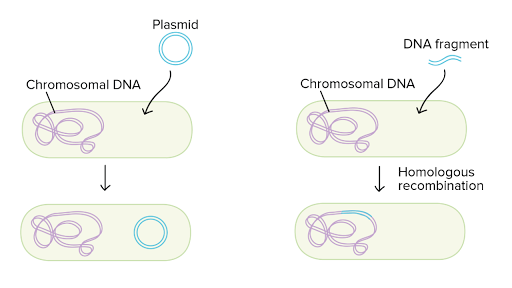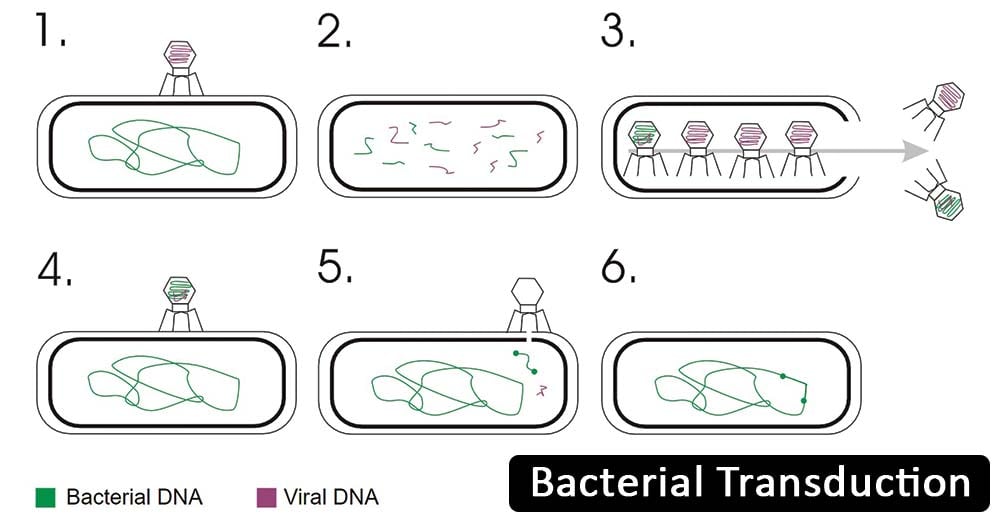The transduction in bacteria occurs in two ways either through a lytic or lysogenic cycle. Bacteria inject DNA into other cells with the help of a tube this process is called Conjugation.

Algae Reproduction Read Biology Ck 12 Foundation Biology Protists Reproduction
Which best describes transduction in bacteria.

. An example would be the infection. Which scientist created tests that helped confirm that bacteria and other microorganisms cause a variety of diseases. This video describes one of the processes of horizontal gene transfer in bacteria which is transduction.
Bacteria usually transfer DNA with the process of transduction. This process was discovered by Zinder and Lederberg. This is a tool that molecular biologists usually use to introduce a foreign gene in a controlled way into the genome of a recipient.
Which Best Describes Transduction In Bacteria. Which best describes transduction in bacteria. Transduction a process of genetic recombination in bacteria in which genes from a host cell a bacterium are incorporated into the genome of a bacterial virus bacteriophage and then carried to another host cell when the bacteriophage initiates another cycle of infection.
Bacteria change from lysogenic to lytic. Bacteria transfer DNA with bacteriophages is called transduction. Thus Option A is correct.
There is no direct contact between the bacterial cells. Which best describes transduction bacteria. Viruses replicate inside a cell and then burst out of the cell.
This is carried out by temperate bacteriophage which undergoes the lysogenic cycle. Bacteria inject DNA into another cell. Bacteria transfer DNA with bacteriophages is called transduction.
Bacteria that transfer DNA to bacteriophage and bacteria that take DNA from their environment best describe bacteria. Bacteria inject dna into another cell. The DNA is inserted by viral vector or virus.
Not all phages are transducing phages. The other ways of genetic recombination in bacteria include transformation and conjugation. The virus particle that infects bacteria is called a bacteriophage or phage and the phages used for the transfer of DNA are called transfusing phages.
In this only a few restricted bacteria are transferred from donor to recipient bacteria. Transduction is a mode of genetic transfer from one bacteria to another through a virus. Transduction is a process by which DNA is transferred from one bacterium to another by the action of a virus.
Thus Option A is correct. April 8 2022 The transfer of genetic code from bacterial host cells bacteria into bacterias genomes as part of their recruitment through transcription or generation of additional genes into their host cells by the bacteria bacterium viruses bacteria in which genes from a host cell a bacterium are. Various DNA sequences of interest can be introduced into Bacterial Cells or Host Genes by transducing into them via Transduction.
The transduction is the process by which foreign DNA is inserted into the cell. The transduction is the process by which foreign DNA is inserted into the cell. The bacteriophage is a virus that replicates within the bacterial cell.
The bacteriophage is a virus that replicates within the bacterial cell. THIS IS THE BEST ANSWER. Bacteria transfer DNA with bacteriophages is called transduction.
What Is Transduction Used For. The bacteriophage is a virus that replicates within the bacterial cell. Try Amazon Luna Now.
Bacteria transfer dna with a bacteriophage. Which best describes the different modes of bacterial reproduction. Bacteria transfer DNA with bacteriophages is called transduction.
Which of the following describes the process of transduction. This process was discovered by Zinder and Lederberg. Bacteria transferring DNA with a bacteriophage and bacteria taking DNA from their environment both best describe transduction in bacteria.
The bacteriophage is a virus that replicates within the bacterial cell. Which best describes conjugation in bacteria. Transduction is the transfer of DNA from one bacterium to another bacterium by the means of bacteria-infecting virus known as bacteriophage.
Helpful 2. When bacteria incorporate foreign DNA into their own best describes transformation in bacteria. Viruses which contain both bacteriophage and plasmid properties like phagemids make up a common method to clone the DNA.
Both the generalised and the specialised process is. Bacteria transferring DNA with a bacteriophage and bacteria taking DNA from their environment both best describe transduction in bacteria. Learn about the discovery of transduction and how.
In general transduction any of the genes of the host cell may be involved in the process. A Intracellular transfer of genes between a chromosome and a plasmid B Plasmid-mediated transfer of bacteria between cells C Uptake and incorporation of DNA from the external environment by a bacterial cell OD Transfer of bacterial DNA mediated by a bacteriophage E Genetic mutation resulting from a transposition. The DNA is inserted by viral vector or virus.
Which best describes how the common cold spreads in the human body. In this process bacteriophages which infect bacteria use host cells to multiplicate and while assembling they. The DNA is inserted by viral vector or virus.
May it helps you. Bacteria take dna from their environment. This process was discovered by Zinder and Lederberg.
The virus enters the bacteria and integrates its genome within the host cell DNA. In binary fission the two new cells that are formed are susceptible to the same antibiotic. Viruses replicate inside respiratory cells.
Transduction is the process by which bacteriophages infect and kill host cells and is necessary to horizontal gene transfers in bacterial cells. It is also used to designate the process by which exogenous DNA is introduced into a cell by a viral vector. It includes the following steps.
The transduction is the process by which foreign DNA is inserted into the cell. It remains dormant and passes on from generation to generation. Transduction is the transfer of bacterial DNA from a donor to a recipient bacterium via a virus particle.
It is the kind of Lytic phase in which the bacteriophage only carries the pure bacterial DNA not the phage DNA and this pure bacterial gene is inserted into the recipient cell. Thus Option A is correct.

Bacterial Transduction Definition Process Advantages Video Lesson Transcript Study Com

Conjugation Transformation Transduction Bacteria Article Khan Academy

0 Comments